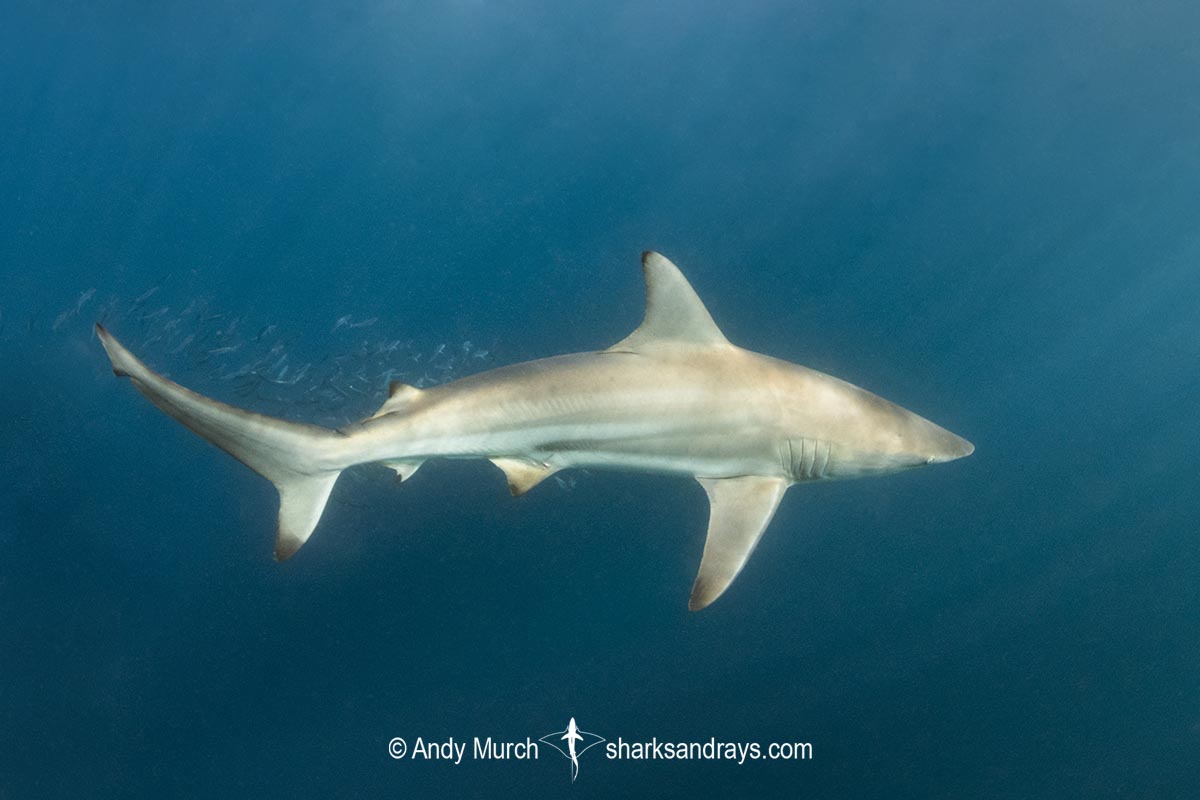Common names
Spinner Shark.
Binomial
Carcharhinus brevipinna.
Synonyms
Aprion brevipinna, Aprionodon brevipenna, Aprionodon brevipinna, Aprionodon caparti, Carcharhinus brevipina, Carcharhinus brevipinnis, Carcharhinus johnsoni, Carcharhinus maculipinnis, Carcharias brevipinna, Carcharinus brevipinna, Carcharinus johnsoni, Isogomphodon maculipinnis, Longmania calamaria, Prionidon brevipinna, Squalus brevipinna, Uranga nasuta.
Identification
Body relatively slender. Snout long, pointed, and somewhat laterally depressed. First dorsal fin origin level with (or slightly posterior to) free rear tip of pectoral fin. Second dorsal origin over anal fin origin. No interdorsal ridge. Dorsal colouration grey-brown or bronzy. Subtle light band on flank. Distinct black tips on most fins in adults; especially obvious and well defined on lower caudal lobe. Black fin tips may be absent or indistinct in juveniles.
Size
Maximum length possibly 278cm. Size at birth 58-65cm.

Conservation Status
VULNERABLE
Due to its low reproductive rate, schooling behavior and largely inshore habitat, the spinner shark is highly susceptible to overfishing. In the northwest Atlantic, spinner sharks are targeted by recreational fishers and by commercial boats along the southeast coast from North Carolina to Florida, and throughout the Gulf of Mexico.
Over the last three generation lengths (38yrs), due to conservation measures in North America the spinner shark population is believed to have increased slightly, but elsewhere it has declined. In the Arabian Sea spinner sharks have declined by 30%. Globally, over the last three generations, spinner shark populations have decreased by 30–49%.
Spinner shark meat is locally marketed under the name “Blacktip Shark” with which it is easily confused. Consequently, it is likely that the species is not recorded in landings data. Spinner shark fins are dried and exported to east Asia for shark fin soup.

Habitat
Warm-temperate and tropical coastlines. From close inshore to the edge of the continental shelf. Found from the surface to at least 75m depth.
Distribution
The spinner shark has a very wide, almost circumtropical distribution, but it has not been recorded in the eastern Pacific. In the western Atlantic, it is present from North Carolina to Venezuela including the Gulf of Mexico. And from northern Brazil to northern Argentina.
It is a seasonally abundant species in South Africa and is present around much of the African continent including Madagascar and islands further north. It is also present across the northern edge of the Indian Ocean, throughout Southeast Asia, northern Australia, and southern Japan.
Reproduction
A viviparous species with yolk-sac placenta. 3-15 pups per litter. Gestation is approximately 12 months. In North America, mating occurs in June, and birthing in May.
Diet
Diet mainly consists of small schooling fishes. Spinner sharks in South Africa predate heavily on pilchards (Sardinops sagax). Spinners are also known to eat stingrays and cephalopods.
Behavior
Spinner sharks are named for their habit of performing aerial leaps and twists when chasing prey. They do not appear to do this in every region so it may depend on specific prey species to warrant this gross expenditure of energy. It has also been suggested that their leaps are performed to rid themselves of parasites.
Spinners congregate in large numbers in the South African winter months to feed on migrating sardines that are corralled into bait balls by pods of common dolphins. Although there is no evidence that the sharks consciously cooperate with the dolphins to corral the fish, they may inadvertently help to pin the bait at the surface by attacking the bait ball from below.
Reaction to divers
Somewhat shy around scuba divers. When focused on feeding, spinners will allow a very close approach but they will abandon a bait ball if divers pursue them too aggressively.
Diving logistics
Spinner sharks are commonly seen during the Sardine Run in South Africa. I have dove on bait balls that were almost exclusively being preyed upon by spinner sharks, and bait balls that had other shark species but no spinners at all, so it is not guaranteed that you will encounter this species during any particular encounter even if the shark action is good.
Apparently, spinner sharks also show up in large numbers during bait fish migrations in Western Australia but the ‘Australian Run’ is far less predictable.
I also ran into a few spinner sharks under an oil rig in the Gulf of Mexico while snorkeling with a large aggregation of baited silky sharks. Although they did not approach closely enough for good images, they seemed comfortable circling slowly about 10m below the silkies.
Similar species
Blacktip Shark Distinguished by its stockier body, more anterior first dorsal fin (origin situated over the pectoral axil), a bolder flank stripe, and some unmarked fins.



